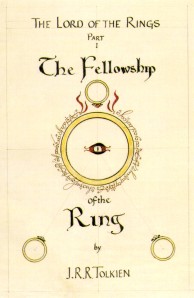 I don’t know what precisely possessed me, but I finally started reading The Lord of the Rings. I’ve spent a lot of time talking about the various writers, Moorcock, Durham, Martin, Leiber, who have in various ways attempted to up-end Tolkein’s model of fantasy.
I don’t know what precisely possessed me, but I finally started reading The Lord of the Rings. I’ve spent a lot of time talking about the various writers, Moorcock, Durham, Martin, Leiber, who have in various ways attempted to up-end Tolkein’s model of fantasy.
In my responses to all of those writers, I sympathized. At any number of levels, I still do. Tolkein’s work is classist and legitimist, and it presents a simplistic moral philosophy in which good and evil appear to be things.
A read of The Fellowship of the Ring confirms at least provisionally all the elements of these critiques. I will say, though, that while, for example, Tolkein indeed presents too simple a dualism of good and evil–it doesn’t, in its simplicity fit my experience of the world–he’s also more interesting in the actual reading than one would imagine from the movies, or The Hobbit.
What struck me was that at one point, almost as an aside but huge in its implications, Gandalf noted that Sauron was not always evil. Now, that is interesting. Having no interest to read the Silmarillion, I used Wikipedia and found that Sauron was more or less a fallen angel as we would find in Milton. This certainly makes for a more interesting read, as a dynamic evil, i.e., subject to change, is vastly superior to a static one, if one is going to adopt a framework of good and evil as a moral philosophy. More interesting as moral philosophy, though it does make Tolkein’s overarching mythology, highly original in its copious, pushing obsessive detail, less so it its broadest, essentially Christian contours. I guess the lesson is that great artists steal.
What was most interesting about the read was not that the moral philosophy was a bit more nuanced than I’d come to expect, and I will say that Tolkein did not surprise me with an unexpected depth of characterization. Really, characterization is his biggest flaw as a writer. Great on conceptualization, not so much on characterization. What really took me surprise, however, was the portrayal of land in the book. My ex began reading The Fellowship of the Ring while we were together, and stopped, citing among other things interminable discussions of hills and dales. Surely, she had a point to make.
For my part, though, I was blown away. Tolkein clearly gave more thought to land than to people. I don’t think this makes him a bad person. I find the long discussions of the land in which the narrative takes place both enormously interesting and politically important. This gets to the contradiction in English politics of the 18th century, one that E.P. Thompson pointed to in his Whigs and Hunters. When I was a kid in school, raised with the politics I was, the Whigs, Liberals, were the good guys in that story and the Tories the bad.
But of course as time passed and I got a fuller story, it became more complex. The good guys weren’t so good, and the bad guys weren’t simply bad. Tories, in seeking to maintain traditional social bonds of necessity recognized, if implicitly, traditional social rights, however imperfectly as I am all too aware they upheld those rights on an individual level in practice. The Whigs, in seeking to “liberalize” social relationships threw the baby of traditional rights to use land, in this case for hunting, necessary for the maintenance of agricultural communities.
So, while working Englishmen in the countryside had reason to fear both Whigs and Tories, in significant ways Tories were much less of a threat than Whigs. Tories–the local, landed aristocrat–were of the land, too, at least in some kind of imagination. I did not expect to see that connection to the land, the aspect of European Conservatism with which I am most sympathetic, so fully displayed in Tolkein, but there it is. Good for Tolkein.